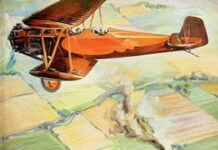The tempo of the drums increased, warning of a ‘war-to-end-all-wars’ that would fail to do so. The role of fixed wing aircraft in military operations was still evolving, but every wing of every army wanted a squadron. Being able to take off from the deep blue ocean seemed to offer a distinct advantage
1911
Eugene Ely Proves It Is Possible to Return to a Ship (January 1911)
Eugene Ely had taken off from a U.S. Navy ship in 1910, but only just made it to the nearest beach. This could have been every fledgling pilot’s nightmare, adrift all alone on the heaving ocean clinging to a sinking wing.
On January 18, 2011 Eugene Ely promised the hope of a solution by landing his Curtiss Pusher airplane on a specially-prepared platform on the stern of armored cruiser USS Pennsylvania, then a fine expression of United States military power.
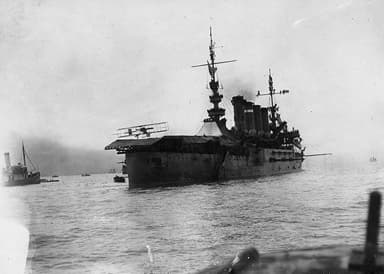
https://en.wikipedia.org/wiki/Eugene_Burton_Ely#/media/File:USS_Pennsylvania_-_First_airplane_landing.jpg
Glen Curtiss Flies First Seaplane in United States (January 2011)
This was not the first take-off from a body of water. Austrian Wilhelm Kress lifted off in his Drachenflieger in1898, while in March 1910 Frenchman Henri Fabre flew his Hydravion trimaran floatplane successfully.
However, Glenn Curtiss was the first American to do so on his A-1 Seaplane and he had many other aviation successes besides. This was an open-framework biplane with two-bay un-staggered wings of equal span. But it used a central pontoon and outriggers under wings instead of tricycle undercarriage. The first flight was on January 26, 1911
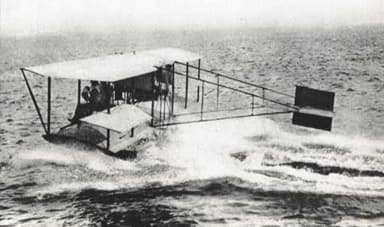
https://veronicathepajamathief365project.wordpress.com/tag/glenn-hammond-curtiss/
The ‘Triad’ as Curtiss called it had interesting innovations to reduce friction on the water when taking off:
1… The outrigger pontoons near the wing tips slanted diagonally backward toward the water
2… The bottoms of each pontoon featured a little hydroplane of wood 3 inches wide by ¼ inch thick

https://www.navalaviationmuseum.org/things-to-do/aircrafts-galleries/
The Triad was able to skim the water at 50 mph and fly for 150 miles between refuelling. However, the additional weight and drag of the floats cost 5 knots of air speed, and so Curtiss added a more powerful Curtiss O V-8, 75 hp water-cooled piston engine, to compensate.
The aircraft was a commercial success, being sold to the U.S. Naval Service, and Aeronautical Division of U.S. Signal Corps. However, all versions were grounded on February 24, 1914, due to concerns over poor safety and reliability records of pusher aircraft generally.
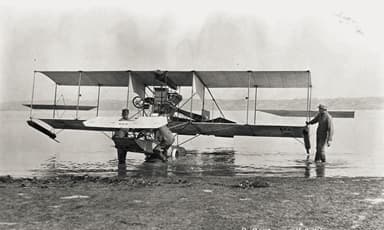
https://www.history.navy.mil/content/history/museums/nnam/education/articles/aircraft-in-the-spotlight/notes-capture-operations-of-a-1-triad.html
Curtiss ‘Lands a Floatplane’ on USS Pennsylvania (February 1911)
There was still one element missing in the Navy-Airplane relationship. How do you land a floatplane on a deck, or for that matter take off and land with wheels on water?
As usual Glen Curtiss had an answer. He put a crane on the deck of the four-stacker armored cruiser USS Pennsylvania, then taxied his Curtiss A-1 Triad in position so the crane could winch them up.
It’s said he luncheoned with the officers before they winched him back down with Curtiss as usual in control. That afternoon he could fly away in triumph and start plotting big orders from the U.S. Navy.

https://www.granger.com/results.asp?image=0642542
More Signs of Increasing Interest in Aerial Warfare (Mar / May 1911)
- Royal Navy pilots begin flight training in a Short S.27 aircraft (March 1, 1911)
- Spain creates the Spanish Airforce and starts pilot training (March 8, 1911)
- Britain establishes her first flying unit, Air Battalion Royal Engineers (April 1, 1911)
- Yoshitoshi Tokugawa flies from Japan’s first permanent airfield (April 11, 1911)
- U.S. creates the US Naval Aviation Service, orders a Curtiss Model D (May 8, 1911)
Avro Type D Later Becomes Britain’s First Float Plane (April 1911)
Designer A V Roe decided to move on from triplanes, and built his first biplane in April 1911. His Avro Type D had a triangular section ash fuselage, divided in two-halves bolted together behind the cockpit for ease of transportation.
It had high aspect ratio wings in an irregular three-bay layout, in which the spacing between the pairs of inter-plane struts increased from the centre section outwards. One 35 hp Green water-cooled engine provided tractor propulsion with the radiator mounted flat behind it.
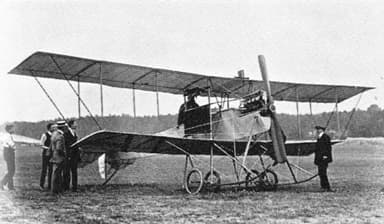
https://alchetron.com/Avro-Type-D
The first Avro Type D flew successfully on April 1, 1911 and reported pleasant and easy to fly. Thereafter it sold for £700 to Oliver Schwann, commander of the Naval Airship Tender Hermione. Schwann was a leading figure in the Royal Naval Air Service, and senior commander in the Royal Air Force during the first half of the 20th century.
The new owner covered the rear section of the fuselage, modified the tail plane, and moved the radiator from behind the engine to a position lying flat over the wing centre section. Then he lashed a series of experimental floats to the skids.

https://en.wikipedia.org/wiki/File:Avro_Type_D_floatplane.jpg
Commander Schwann took to the air in his modified Avro Type D on November 18, 1911. This made it the first seaplane to take off from British sea water. However, the Royal Aircraft Factory returned the airplane to the original design the following year, after which it became a regular landplane again.
The specification was as follows:
- Length 28 ft, wingspan 31 ft, height 9 ft, wing area 310 sq ft
- Gross weight 500 lb, 1 crew, 2-bladed fixed-pitch propeller, 49 mph
- Green 35 hp C.4 4-cylinder water-cooled in-line piston engine
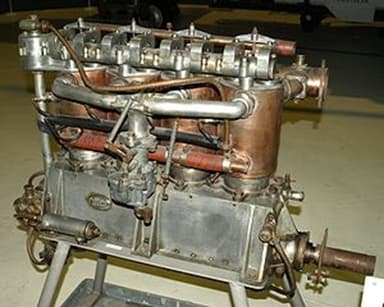
https://en.wikipedia.org/wiki/Green_C.4#/media/File:GreenC4.JPG
Blackburn Achieves Success with Mercury Monoplane (May 1911)
The Blackburn Aeroplane Company in Yorkshire, England had mixed success with its First and Second Monoplanes. However, things came together with its Blackburn Mercury Monoplane that followed, and first took to the air on May 17, 1911.
The original Blackburn Mercury was a mid-wing, two-seater monoplane trainer, accommodating pilot and student in tandem, open cockpits. The prototype crashed during the Daily Mail Circuit of Britain Race. The second survived to be refashioned as a single-seater trainer. A further six variants were made to order for various buyers.
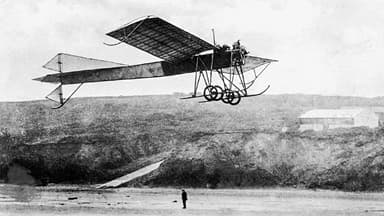
https://www.baesystems.com/en/heritage/blackburn-mercury
The original specification of the two-seater version was as follows:
- Length 33 ft, height 6 ft, wingspan 38 ft, wing area 288 sq ft
- Isaacson 7-cylinder air-cooled radial piston engine, 50 hp
- Two-bladed fixed-pitch propeller, maximum speed 60 mph

https://en.wikipedia.org/wiki/Blackburn_Mercury#/media/File:Blackburn_Mercury_1_(Nigel_Coates).jpg
Wright ‘Vin Fiz’ Flies Over the U.S. Coast to Coast (Sept 1911)
There were many flights of endurance and records broken during the period April to September, 1911, although the Vin Fiz journey was the most remarkable. However, prior to it during this period:
- American Harry Nelson Atwood flew 576 miles from Boston MS to Washington DC landing on the White House lawn in a Wright aircraft.
- Frenchman Jean Louis Conneau alias André Beaumont won the first Daily Mail Circuit of Britain air race starting and finishing at Brooklands and ending August 5, 2011
- American Harry Nelson Atwood flew 1,256 miles from St. Louis, Missouri, to Governors Island in New York Harbor, over a 110-day period with scheduled stops after spending 28 hours 31 minutes in the air. And then …

https://en.wikipedia.org/wiki/Vin_Fiz_Flyer#/media/File:%22Vin_Fiz%22_Wright_Model_EX_takes_off_from_Sheepshead_Bay.jpg
Publisher William Randolph Hearst offered a US$50,000 prize to the first aviator to fly the United States coast to coast, in either direction, in less than 30 days from start to finish.
Avid yachtsman and motorcycle racer Calbraith Perry Rodgers decided to take up the challenge, after 90 minutes of aviation training from Orville Wright in July that year. He became the first private citizen to own a Wright airplane, after he purchased a Wright Model B capable of a speed of 50 miles per hour at 1,000 feet.
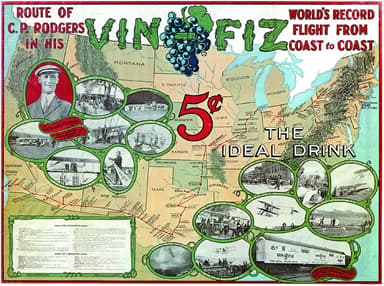
https://en.wikipedia.org/wiki/File:Vin_Fiz_first_American_transcontinental_flight_advertisement_poster.jpg
Calbraith Rogers was clearly not a man satisfied with half measures. He envisaged a special train of three cars, including sleeper, diner, and shop-on-wheels full of spare parts, to follow him as he flew above the railroad tracks. A grape juice soft drink company making ‘Vin Fiz’ agreed to sponsor him in exchange for naming rights over his airplane.
The trans-continental flight began at 4:30 pm, September 17, 1911, when Rodgers took off from the Sheepshead Bay Race Track in Brooklyn, New York to meet the 30 day challenge. As it turned out there were 75 stops along the way, including 16 crashes. One of these left Rogers with brain concussion and a spinal twist, requiring three weeks in hospital.

https://pioneersofflight.si.edu/content/calbraith-perry-rodgers0
The journey completed on December 10, 1911, when Rogers reached Long Beach, California after travelling just over 4,000 miles with the first transcontinental U.S. Mail pouch. He landed in the beach and taxied into the Atlantic Ocean, 19 days beyond the competition deadline, but to the enthusiastic cheers of some 50,000 people.
The Smithsonian Institute acquired the Gin Fiz airplane in 1934, and added it to the National Air and Space Museum after renovation through to 1960. It had followed a checkered life before then, being repaired and rebuilt so often that parts were continuously exchanged. But there was enough that was original to ensure an authentic rebuild.

https://travelforaircraft.wordpress.com/2012/02/13/calbraith-cal-perry-rodgers-his-wright-ex-and-a-new-grape-soda-the-making-of-aviation-history/
The specification of the Wright Gin Fiz Flyer was as follows:
- Length 21 ft, height 7 ft, wingspan 32 ft, gross weight 903 lb
- Wright Aero Four cylinder four cycle (35 hp) engine, 2-bladed propeller
- One crew member (pilot), 51 mph average ground speed on trip
Nieuport IV Becomes Leading Reconnaissance Airplane (Mid 1911)
Édouard Nieuport and his brother Charles formed their aircraft manufacturing company, Société Anonyme Des Établissements Nieuport at Issy-les-Moulineaux, France in 1909. However, they only achieved real international fame in mid-1911, when their Nieuport IV attracted the attention of the military.
The Nieuport brothers originally planned to build a two-seater sporting and racing monoplane. However, the generals of several countries envisaged a spotting role for them too, including Argentina, Greece, Japan, Russia, Siam, Sweden, and the United Kingdom. Several hundred were manufactured, including roughly 300 in Russia.
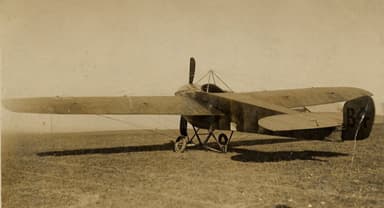
https://en.wikipedia.org/wiki/File:RFC_Nieuport_IVG_serialled_B4.jpg
The general specification of the Nieuport 4 series was as follows:
- Length 26 ft, wingspan 39 ft, wing area 237 sq ft, empty weight 1,065 lb
- Crew 2, Gnome rotary piston engine 100 hp, maximum speed 75 mph
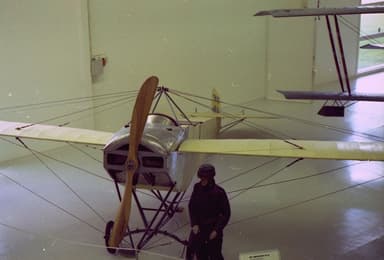
https://en.wikipedia.org/wiki/Nieuport_IV#/media/File:Nieuport_IVG_at_Malmso.jpg
First Fixed Wing, Military Operational Flight (October 1911)
The First World War was only a few years in the future, and it would play a huge role in shaping the future of flight. The world had its first insight into this, when Italian Captain Carlo Piazza climbed onto his spindly Blériot XI and made military history. His army unit he was attached to as pilot was facing the Ottoman Army during the Italo-Turkish War.
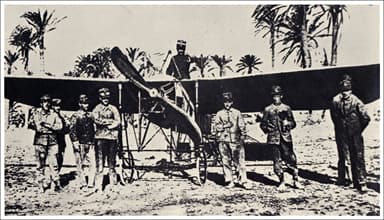
https://www.airspacemag.com/daily-planet/the-worlds-first-warplane-115175678/
On October 22, 1911 Caro Piazza completed the world’s first reconnaissance flight while serving in the Italian Army Specialist Battalion. His Blériot XI aircraft was like a delicate dragonfly with a 25 hp motor, no instruments, and Wright brothers’-style wing-warping as main flight control.
Yet he was so successful his compatriot Captain Moizo made a second flight, this time in an Italian Nieuport airplane later the same day. However, he was less successful when his aircraft took several direct hits from Turkish ground fire. Although he was able to return to base and land safely.
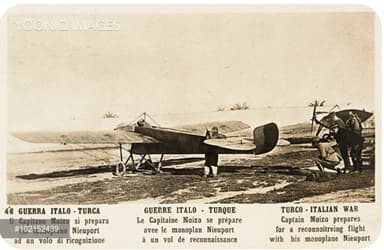
https://www.pinterest.nz/pin/462181980499263663/
Sourced From https://www.pinterest.nz/jezwyndham/monoplanes-of-ww1/
Taube Monoplane Directs Naval Gunfire (October 1911)
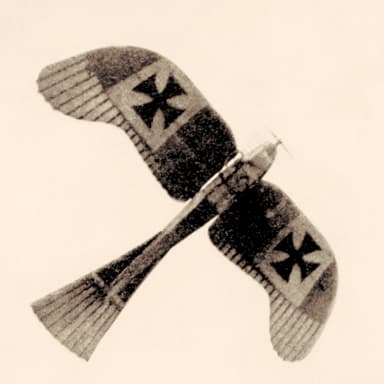
https://en.wikipedia.org/wiki/File:Rumpler_Taube_monoplane.jpg
The Taube was a German monoplane mass-produced in Germany, but also outsourced to other manufacturers as bomber, surveillance aircraft, and also as trainer. In the latter instance, the manufacturer added a suffix to the Taube name. On October 26, 1911 an Eric Taube version directed naval gunfire for the first time. That was when she spotted fire for the Italian Royal Navy armored cruiser Carlo Alberto as she fired at Ottoman Army positions ashore in Libya.
Austro-Hungarian designer Igo Etrich first flew the aircraft in 1910 he named for a dove. The wing had three spars and was braced by a cable-braced steel tube truss under each wing. The design employed wing warping as opposed to ailerons to control roll, and also warped the rear half of the stabilizer to function as the elevator.
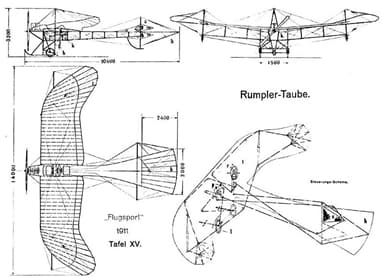
https://en.wikipedia.org/wiki/File:RumplerTaubeDesign1911.jpg
The general specification of the Taube was as follows:
- Length 23 ft, height 10 ft, wingspan 46 ft, wing area 350 sq ft
- Empty weight 1,433 lb, gross weight 1,874 lb, crew 2
- Mercedes Type E4F 4-cyl. water-cooled piston engine, 86 hp
- Max speed 62 mph, range 87 mi, service ceiling 6,000 ft

https://en.wikipedia.org/wiki/Etrich_Taube#/media/File:Jeannin_Stahltaube_1.jpg
Giulio Gavotti Drops Live Bombs on Turkish Ottomans (Nov 1911)
The innocent dream of flying free as a bird began to tarnish in the sky over the Italo-Turkish War. The Italian Army had control over the air, and it continued experimenting with it as the world watched.
Giulio Gavotti was an Italian lieutenant and pilot who left two footsteps in the sand. The first of these was the earliest aerial bombardment, while the second was performing the first night combat mission in Libya in March 2012.
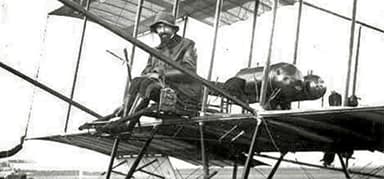
https://www.wearethemighty.com/mighty-history/the-first-aerial-bombing-run-was-made-by-the-italian-army/
Giulio Gavotti took off from behind the Italian frontline in his early model Etrich Taube monoplane on November 1, 1911. He later wrote to his father, ‘With one hand, I hold the steering wheel, with the other I take out one of the bombs and put it on my lap…. I take the bomb with my right hand, pull off the security tag and throw the bomb out, avoiding the wing.’
Three of the grenades fell into the Tagiura Oasis, while the fourth landed in the Turkish military camp at Ain Zara. The munitions functioned correctly. However, there were no reports of casualties or collateral damage.
The Turkish Ottoman Empire lodged a complaint in terms of the Hague Convention of 1899 that outlawed dropping bombs from aerial balloons. The Italian Army countered that an Etrich Taube monoplane was not a balloon, and the world’s first bombing run was therefore not illegal.
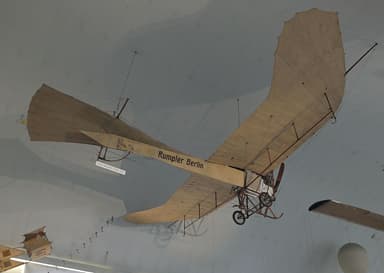
https://commons.wikimedia.org/wiki/Category:Etrich_Taube_museum_aircraft#/media/File:Munich_Deutsches_Museum_Etrich_Rumpler_19_01.jpg
1912
Curtis Model F Seaplane Takes to the Air (January 1912)
There were various attempts with float planes during 1911 and 1912. However, Glen Curtis was arguably the first aviator to integrate the buoyancy with the fuselage, as opposed to fitting it with floats. His two-seater Model F Utility flying boat launched from the water on January 12, 1912 and established a legend.

https://en.wikipedia.org/wiki/File:Curtiss_f_floatplane.jpg
Curtis’ design incorporated a single engine mounted amongst the interplane struts and driving a pusher propeller. While the wings came from his Model E landplane. That name transposed to early models he sold in 1912. The Model F designation only made an appearance later.
The United States Navy purchased several, and they were used for scouting missions and training from 1914 onwards. Commercial versions were still flying as late as 1927, when Rogers Airlines flew routes out of Miami and Nassau in the winter. And returned to upstate New York for maintenance and barnstorming in the summer.
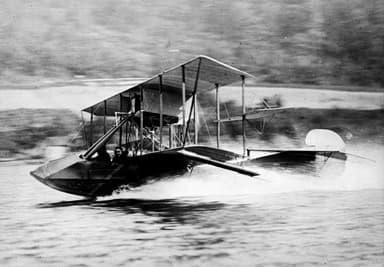
https://en.wikipedia.org/wiki/Curtiss_Model_F#/media/File:Curtiss_F_of_GM_Heckscher_c1912.jpg
The specification was as follows:
- Length 27 ft, height 11 ft, wingspan 45 ft, wing area 377 sq ft
- Empty weight 1,860 lb, gross weight 2,460 lb, 2 crew
- 2-bladed fixed-pitch pusher propeller, max speed 69 mph
- Curtiss OXX-3 V-8 water-cooled piston engine, 100 hp
- Endurance 5 hr 30 min, service ceiling 4,500 ft, 10 min to 2,500 ft
Jules Védrines Flies 105 mph in Deperdussin Monoplane (Feb 1912)
The 1912 Deperdussin racing monoplane was the first aircraft to exceed 100 mph in the air. Its wings were tapered, so their chord was greater at the tips than at the root. This may have been to increase the effect of wing-warping used for lateral control.
The fuselage was a wooden box-girder entirely skinned with plywood, with the rounded top and bottom built up from laminations of wood. Great attention was taken to produce an aerodynamically clean design. Even the wing-warping control wires were carried inside the inverted-v cabane struts stiffening the airframe.

(L – R Guillaume Busson, René Vidart, Jules Védrines and Maurice Prévost)
https://en.wikipedia.org/wiki/File:Adt_busson_mono2.jpg
Jules Charles Toussaint Védrines was at the controls of a Deperdussin 1912 Racing Monoplane when he became the first person to fly an aircraft at more than 100 mph in level flight. Almost as an aside he also won the Gordon Bennett Trophy race. He covered the 120 miles in 1 h, 15 min, 20.8 s, an average speed of 105 mph.
The specification was a follows:
- Length 23 ft, wingspan 20 ft, wing area 100 sq ft, crew one
- 2-blade Chauvière propellers, max speed 105 mph flying a circuit
- Gnome Lambda Lambda 14-cylinder twin-row air-cooled rotary, 190 hp

https://en.wikipedia.org/wiki/File:Deperdussin_racer_-_Aero_and_Hydro_volume_1_pg_147.png
World’s First All-Metal Aircraft Takes to The Air (A Day in March 1912)
The Ponche et Primard Tubavion was a French experimental monoplane with a metal fuselage and wings. Charles Ponche and Maurice Primard had begun their work on it in 1911. A version appeared at the 1911 Paris Auto Show, and by April 6, 1912 had completed its ‘official tests’.
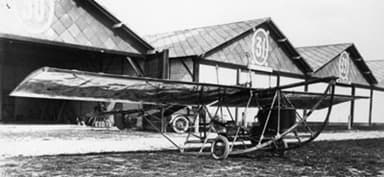
http://all-aero.com/index.php/contactus/54-planes-p-q-e-r-s/18609-ponche-pimard-tubavion
In March 1912 on a day between those two peg points Tubavion took to the air, perhaps for the first time. No much more is known about it, except for this intriguing link. However, it must have been successful, because development continued until Ponche was killed in an aircraft accident on February 10, 1916.
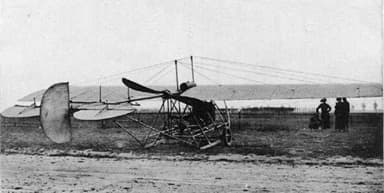
https://www.aviafrance.com/ponche-et-primard-tubavion–aviation-france-10176.htm
The specification of the aircraft was as follows:
- Length 27 ft, wing span 26 ft, wing area 215 sq ft, 2 crew
- Empty weight 926 lb, 2-bladed fixed-pitch pusher propeller
- Labor 4-cylinder water-cooled in-line piston engine, 70 hp at 800 rpm

http://long80.com/letubavion.html
Aerial Experiment Association’s Cygnet Fails (March 1912)
Alexander Graham Bell continued to stretch the outer boundaries of powered flight under the aegis of the Aerial Experiment Association. This time it was a powered version of the tetrahedral kite he invented in 1907. But he was more ambitious and assembled 3,393 tetrahedral cells into a ‘wall-like wing”.
An unpowered version, Cygnet 1 had successfully towed behind a motorboat with Thomas Selfridge as pilot in December, 1907. It reached a height of 168 feet on one occasion, making it the first recorded heavier-than-air flight in Canada. However it was difficult to control, and destroyed when it hit the water at the end of the flight. But that was not the end of the story of the Cygnet.

https://en.wikipedia.org/wiki/File:AEA_Cygnet_II.jpg
Bell fitted a Curtiss V-8 engine to a new, smaller version, Cygnet 2, however it failed to fly between 22 and 24 February 1909. Then in 1912 he rebuilt it with a more powerful 70 hp Gnome Gamma engine. But John McCurdy’s attempts to fly the experiment on March 19, 1912 at Bras d’Or Lake, Nova Scotia were unsuccessful, with Cygnet 3 barely lifting off the ground.
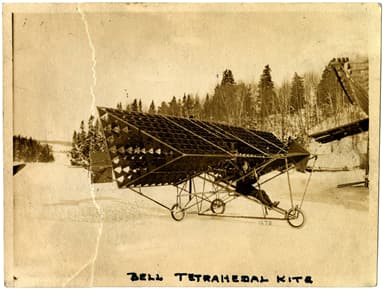
https://www.reddit.com/r/WeirdWings/comments/abhs0f/aerial_experiment_association_cygnet_iii_designed/
First Seaplane Carrier Ready for Action (Late March 1912)
The Canard Voisin float-equipped seaplane inspired the French Navy to equip its torpedo boat tender Foudre as mother ship. This involved installing a hangar on the deck for storing aircraft, and dual cranes for placing them on the water, and retrieving them when they returned. The final touch was fitting a launch deck at the stern in November 1913.
Although the launch deck was only commissioned in 1913, the cranes were ready for use by March 1912, having proved capable of retrieving a seaplane from the hangar and placing it on the ocean surface, and reversing the process when it returned after a practice flight.
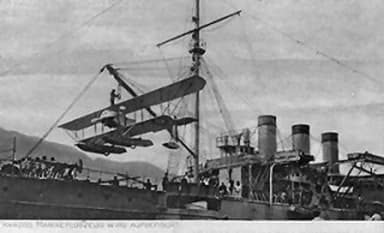
https://www.battleships-cruisers.co.uk/french_aircraft_carriers.htm
The French Navy purchased a monoplane Breguet with a single float, a Nieuport with double float, and a converted Farman biplane in May 1912, and began tactical exercises in the Mediterranean the next month. Foudre served successfully as seaplane carrier, aircraft transport, and headquarters ship during World War 1 that followed.
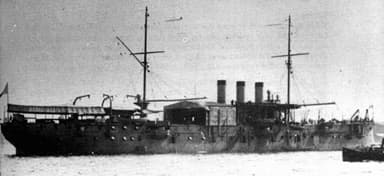
https://en.wikipedia.org/wiki/French_seaplane_carrier_Foudre#/media/File:LeFoudre.jpg
NOTE: HMS Hermes was temporarily converted as an experimental seaplane carrier for two months in April to May 1913, and is considered by many to actually be the first complete seaplane carrier.
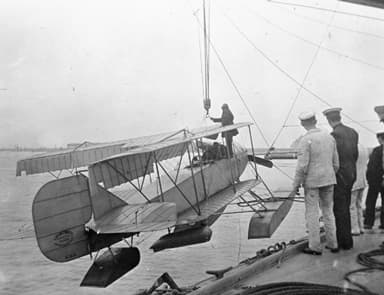
https://en.wikipedia.org/wiki/HMS_Hermes_(1898)#/media/File:Short_Folder_S.64_IWM_Q_090115.jpg
First Aircraft Flight from a Deck of a Moving Ship (May 1912)
Charles Rumney Samson was a career English sailor who rose steadily up the ranks from naval cadet to air commodore. Two of his career highlights were successfully flying an airplane off the deck of a moving ship, and commanding the first British armored vehicles used in combat.
Samson’s aviation career began when he was selected as one of the first four Royal Navy officers to receive pilot training, and obtained his Royal Aero Club certificate on 25 April 1911 after only 71 minutes flying time. He flew a Short Improved S.27 from a ramp mounted on the foredeck of battleship Africa at anchor on January 10, 1912. But that was only an appetizer for what followed on Hibernia.
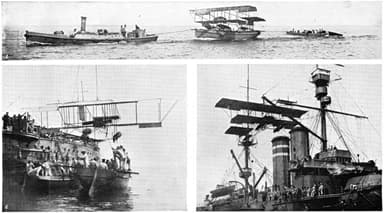
https://en.wikipedia.org/wiki/File:Wn21-05.jpg
The military transferred the temporary runway from battleship Africa to the pre-dreadnought Hibernia, and located it on her foredeck stretching from her 12-inch turret to her bows. Charles Sampson took off from it on May 9, 1912, while Hibernia steamed at 10.5 knots (12.1 mph). The occasion was a fleet review where King George V witnessed the event.
The first lords of the admiralty were convinced of naval air potential. However, they concluded interference with guns, and the danger and impracticality of recovering seaplanes in unpredictable weather rendered it impractical. Clearly, some other innovation was needed.
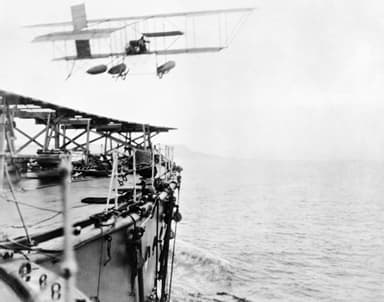
https://en.wikipedia.org/wiki/Charles_Rumney_Samson#/media/File:HMS_Hibernia_first_ship_aircraft_takeoff_1912_IWM_Q_71041.jpg
First Attempt to Launch an Airplane Using a Catapult (July 1912)
An aircraft catapult is an external device that allows an aircraft to take off from a very limited amount of space, such as the deck of a vessel. However, there are also rare examples of installed land-based runways.
Various forms of energy have been deployed down the years, such as weight and derrick, gunpowder, flywheel, air pressure, hydraulic, steam power, and solid fuel rocket boosters.
Theodore Gordon Ellyson alias ‘Spuds’ was the first designated ‘Naval Aviator’ in the U.S. military. He served in the sphere of experimental aviation development in the years before and after World War I. On July 31, 1912 he participated in the world’s first live catapult test.
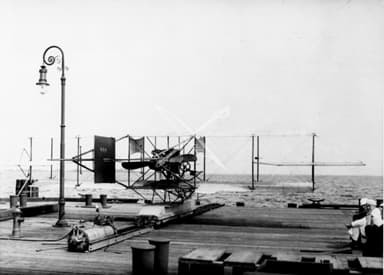
https://photos.usni.org/content/9875650png
The experiment involved a compressed-air catapult system mounted on the Santee Dock in Annapolis, Maryland. Ellyson’s life was under threat when the airplane left the ramp with its nose pointing upward, and it caught a crosswind pushing the plane into the water.
However he managed to escape the wreckage, and survived to make the second, successful attempt on October 12, 1912. That was when he made history by completing the Navy’s first successful catapult launch, this time from a stationary coal barge.
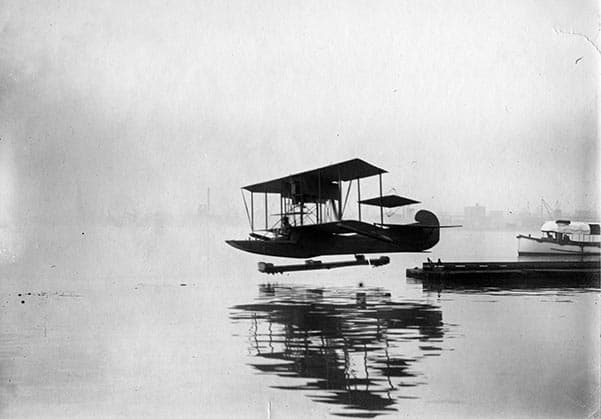
https://commons.wikimedia.org/wiki/File:UA_41.01.05_(26949302004).jpg
Cody V Wins British Military Airplane Competition (August 1912)
In 1911 the British War Office decided fixed wing aircraft had reached the point they were militarily significant. France across the Channel less than an hour’s flight away already had 200 aircraft in military service, while Britain only had 19 in various states of repair.
Accordingly, the Royal Flying Corps launched a competition to find the best model for pilot training, and combat should war break out. The requirements were published in December, 1911. The British Military Airplane Competition trials completed in August 1912 with the Cody V Biplane declared the overall winner.
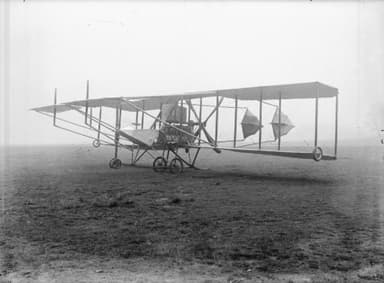
https://en.wikipedia.org/wiki/File:Cody_aircraft_mark_V_RAE-O354.jpg
The specification for entrants was as follows:
- Transport a 350 lb live load for 4.5 hours over and above equipment, instruments, fuel and oil
- Climb to 1,000 ft in 5 minutes on full load, reach and maintain altitude of 4,500 ft for one hour
- Accommodate one pilot and one observer with controls that pilot or observer could operate
- Take off within 100 yards in calm weather from long grass or rough ground and reach 55 mph air speed
- A pilot of ‘ordinary skill’ should be able to land without damage to aircraft or injury on cultivated land.
Competing aircraft had to arrive by road in a crate of a particular size, and be assembled at the Larkhill competition site on Salisbury Plain. Their design should facilitate dismantling and transport by road or rail. Ease of rigging and derigging would be among decision criteria. There were 32 entrants.
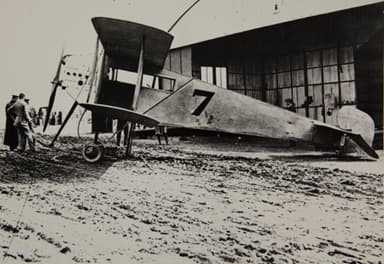
Link to Image
The Cody V airplane won the competition, despite several other competitors, including the Hanriot Monoplane apparently demonstrating better all-round performance. The Royal Flying Corps purchased the demonstration model and ordered a second.
The first prototype broke up in the air the following year. An accident investigation determined the structure ‘had deteriorated badly and was in “precarious” condition by the time of the crash’. The second one, awaiting repair from a previous accident never flew again. It was presented to the Science Museum, London, where it has been on display ever since.
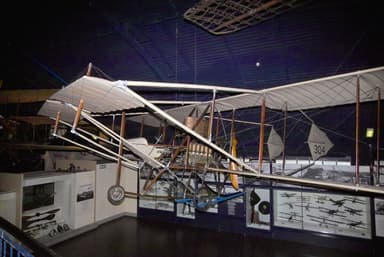
https://en.wikipedia.org/wiki/Cody_V_biplane#/media/File:Cody_V_biplane_-_Science_Museum.jpg
Britain Orders First Purpose-Built Fighter Aircraft (October 1912)
The Vickers E.F.B.1 ‘Destroyer’ may not have been a technical success, with the weight of the armament causing it to nose down. But it was an early example of the customer dictating the design. It was also the first in a series of prototypes, eventually leading to the Vickers F.B.5 ‘Gunbus’, which saw widespread service during World War I.
Experimental Fighting Biplane No. 1 was a response to the British Admiralty specifying a fixed wing aircraft from a military perspective. The need for a forward-firing gun dictated a pusher propulsion layout, because gun synchronization was unknown at the time.
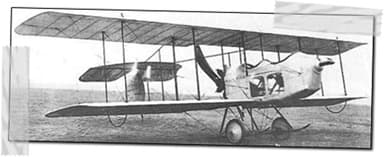
http://todayinaviation.com/vickers-efb1/
The result, as interpreted by Vickers, was an aircraft with unequal-span staggered wings, a tail plane mounted on booms behind them, and two crew in a nacelle ahead of the engine. The tail booms behind the wings, the wing spars and the outer casing of the nacelle were all made of steel.
Lateral control was achieved by wing warping. However, this time the rear wing spar was in three sections, with the upper and lower ones hinged off the center one to prevent structural fatigue. The wing ribs were also loosely threaded with this mind. There was a single belt-fed 0.303 Vickers-Maxim machine gun at the front of the nacelle on a flexible mounting.
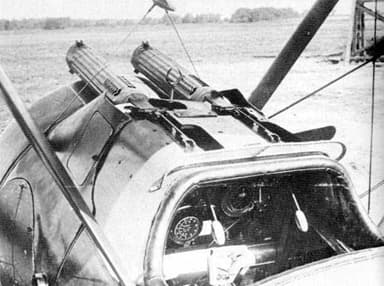
http://www.aviation-history.com/guns/vickers.htm
The specification of the aircraft was as follows:
- Length 27 ft, upper wingspan 40 ft, lower wingspan 30 ft, crew 2
- Empty weight 1,760 lb, gross 2,660 lb, 4-bladed Vickers-Levasseur propeller
- Wolseley Type B V-8 air-cooled piston engine, 80 hp, water-cooled valves
- Maximum speed 70 mph, endurance 4.5 hours, rate of climb 450 ft/min
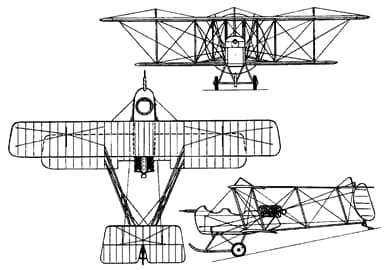
http://www.aviastar.org/air/england/vickers_fb-1.php
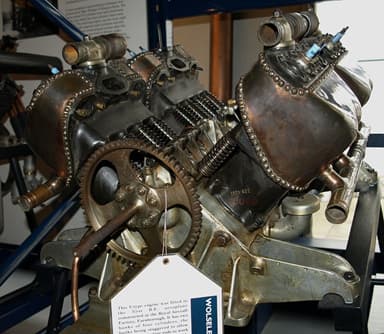
https://en.wikipedia.org/wiki/Wolseley_60_hp#/media/File:Wolseley60.JPG
Yōzō Kaneko Appears at Japanese Navy Fleet Review (Nov 1912)
Yōzō Kaneko was a pilot in the Imperial Japanese Navy, and the founder of the Imperial Japanese Navy Air Service. He trained at the Imperial Japanese Naval Academy and played a role in the Battle of Tsushima (Naval Battle of the Sea of Japan).
Then in 1911 the Navy sent him to France to train as a pilot. Upon his return, he and a colleague made the first airplane flights in Japan in Farman and Curtiss seaplanes on November 2, 1912. On November 12 of that year Yōzō Kaneko demonstrated a Farman seaplane before the Japanese Navy fleet review at Yokohama.

https://commons.wikimedia.org/wiki/File:Farman-seaplane-japan.jpg
1913
1913 Was a Busy Period as the World Prepared for Aerial Warfare
There were unmistakable signs of a sense of urgency among the world’s nations to develop air forces through 1913, although Germany still seemed more interested in its zeppelins at this time.
- Serbia established an army air service and sent six officers to train in France
- Rebel forces attacked federal elements from the air during the Mexican revolution
- The Imperial Japanese Navy ordered a naval float plane tender the Wakamiya
- Imperial Russian Navy embarked a Curtiss floatplane on a cruiser in the Black Sea
- Royal Swedish Navy acquired its first seaplane, perhaps Bleriot XI or a Nieuport IV.M
- A Sopwith Type C floatplane lifted a 14 in, 900 lb torpedo in the air in the UK.
- The Republic of China acquired twelve military aircraft from France of unknown type
Sikorsky Flies First Four-Engine, Fixed Wing Aircraft (May 1913)
Igor Sikorsky was a Russian-American aviation pioneer in both helicopters and fixed-wing aircraft. On May 26, 1913 he flew the first four engine, fixed wing aircraft, the ‘Bolshoi ‘Baltisky’ biplane for the Imperial Russian Air Service. This was a powerful prototype of the later Sikorsky Ilya Muromets with these impressive statistics:
- Four 229 horse power engines and 1,543 lb bomb payload
- Space for five crew, four machine guns and the first airborne lavatory
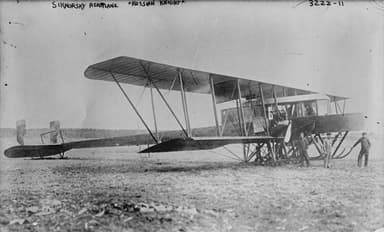
https://en.wikipedia.org/wiki/File:Sikorsky-LeGrand.jpg
The multi-bay biplane had dual-spar wings with a rectangular platform, and a chord and wing gap both of 8 ft. Plywood sheets covered the rectangular section girder fuselage.
There was a dual control cabin, two passenger cabins, and a store room for spares. Plus an open deck ahead of the pilots kitted out with a searchlight and machine gun. Stability was provided by ailerons on the upper wings.

https://en.wikipedia.org/wiki/File:Sikorsky_Russky_Vityaz_(Le_Grand).jpg
The giant aircraft first flew on May 26, 1913 after a 2,300-foot take off run. She was stable to the extent passengers could even walk around the cabins. However, an engine from a single-seater Morane aircraft flying overhead fell off, and crushed it during a landing the following month.
Sikorsky abandoned the wreck and began developing the next version, the Ilya Muromets which saw action during the revolution and First World War. After that, a few delivered passenger services between Moscow and Khatkov for a while.
The general specification of the aircraft was as follows:
- Length 37 ft, height 13 ft, upper wing span 97 ft, lower wing span 68 ft
- Wing area 1,350 sq ft, empty weight 6,945 lb, gross weight 10,141 lb
- Crew four to eight (maximum twelve), 2-bladed fixed-pitch propellers
- 4 × Sunbeam Crusader V-8 water-cooled piston engines 150 hp each
- Speed 68 mph, ceiling 9,800 ft, endurance 5 hours without armament

https://en.wikipedia.org/wiki/Sikorsky_Ilya_Muromets#/media/File:Replica_Sikorsky_S-22_Ilya_Muromets_-_Monino_(9728150992).jpg
Seaplanes Part of British Naval Annual Maneuvers (July, 1913)
HMS Hermes was an aging British protected cruiser, reaching the end of her service when the navy modified her as an experimental seaplane carrier in 1913. This involved installing a temporary flight deck reaching from over her main armament to the tip of her bow.

https://www.quora.com/If-the-Royal-Navy-gets-a-third-carrier-what-should-it-be-named-and-why
The British Royal Navy annual maneuvers were underway when HMS Hermes embarked two seaplanes, a British Short Folder S.64 biplane with newly-patented folding wings, and a French Caudron G.3 amphibian.
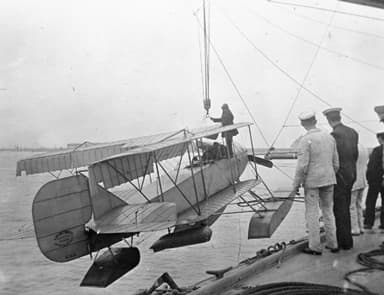
https://en.wikipedia.org/wiki/File:Short_Folder_S.64_IWM_Q_090115.jpg
The first flight on July 5, 1913 was a success. By the end of the maneuvers the exercise had demonstrated both the feasibility of extended operations by aircraft at sea, and the value of folding wings.
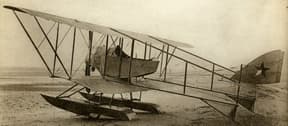
https://en.wikipedia.org/wiki/Caudron_G.3#/media/File:Caudron_G.3_in_Chinese_service.jpg
Bristol T.B.8 Biplane with Undercarriage & Floats (August 1913)
Romanian Henri Coandă was chief designer of the Bristol Aeroplane Company when he converted his earlier Bristol-Coanda Monoplane. The Bristol T.B.8 (or Bristol-Coanda T.B.8) performed a trainer and brief bomber role, and was tested with both wheeled undercarriage and floats.

http://flyingmachines.ru/Site2/Crafts/Craft25626.htm
A British Admiralty order inspired Henri Coandă’s conversion. This was successful in that the Royal Naval Air Service briefly used a T.B.8 as a bomber at the start of World War I. Early versions used wing warping for stability, although ailerons appeared on later versions.
The order was fulfilled using both new and converted aircraft. One airplane had a prismatic bombsight in the front cockpit. And a cylindrical bomb carrier in the lower forward fuselage, capable of carrying twelve, ten pound bombs, which could drop singly or as a salvo as required.
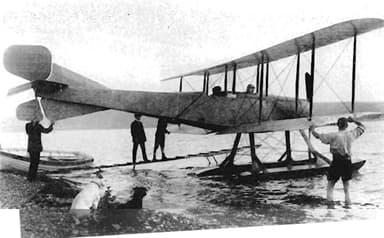
https://www.flickriver.com/photos/27862259@N02/6413553633/
Both the Royal Naval Air Service, and the Royal Flying Corps purchased Bristol T.B.8’s, with the latter transferred to Royal Navy Air Service shortly after the start of World War I.
Three went to France at the start of hostilities. One of these executed a bombing attack on German gun batteries at Middelkerke, Belgium on 25 November 1914. However, the aircraft was too slow for military operations, and was relegated to a training role through to 1916.
The specification of the aircraft was as follows:
- Length 29 ft, wing span 37 ft, wing area 450 sq ft, crew 2
- Empty weight 970 lb, gross weight 1,665 lb, 2-bladed fixed-pitch propeller
- Gnome Lambda 7-cylinder air-cooled rotary piston engine, 80 hp
- Max speed 65–70 mph, endurance 5 hours, 3,000 ft in 11 minutes
- 12 x 10 lb light bombs, Some were equipped with a 7.92 machine gun

http://flyingmachines.ru/Site2/Crafts/Craft25626.htm
First Inverted, Upside Down Flight of an Airplane (September, 1913)
Adolphe Célestin Pégoud was a French aviator and instructor who became the first fighter ace in the First World War. He met his nemesis in 1916, when one of his pre-war German students shot him down, killing him.
However, by that time he had already achieved a number of firsts, including making the first parachute jump from an airplane. He observed the flight path of the sacrificial airplane, and later said ‘I’ve seen him, alone, looping the loop. So you see that this is possible. Also, I will try.’

https://za.pinterest.com/pin/463237511650619125/
First, Pégoud tested a Blériot Model XI monoplane in a series of test flights exploring the limits of airplane maneuvers. Then he modified it, and flew it upside down for a quarter mile on September 1, 1911. Then, on September 21 he flew what was widely publicized and believed by many to be the first loop.
However, this was not entirely correct, because Russian Pyotr Nikolayevich Nesterov may have already achieved that a few days earlier on September 9, 1913. But history was kinder to Pégoud, than to the Russian pilot, an aircraft designer and an aerobatics pioneer.
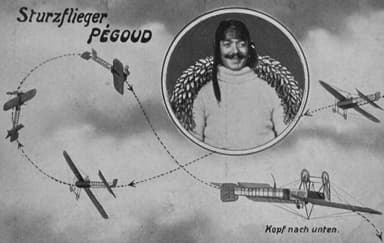
https://en.wikipedia.org/wiki/File:Adolphe_P%C3%A9goud_Looping.jpg
Grigorovich M-1 Flying Boat Takes to The Air in Autumn 1913
Dmitry Pavlovich Grigorovich was a Ukrainian, Russian and Soviet aircraft designer of a number of airplanes branded under his name. His Grigorovich M-1 seaplane may only qualify for a footnote in the pages of aviation history, but it did lead to further developments during World War 1.

https://www.ecured.cu/Grigorovich/Schetinin_M-1
The Grigorovich M-1 seaplane was to a large extent similar to the French Donnet-Lévêcque built in 1912. Therefore, it was of mixed construction with two pilots seated side-by-side. Support floats at the end of the lower wing stabilized the aircraft in water, while there were attachment points for a dolly to bring the aircraft in and out.
However, Grigorovich shortened the nose of the Donnet-Lévêcque design by about three feet, altered the wing profile, and reduced the hull step of 8 inches to approximately three inches. The Grigorovich M-1 flew successfully in the autumn of 1913, and fulfilled expectations in terms of improved handling. Quite large numbers were made for military purposes in later versions.
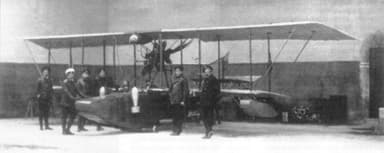
https://www.ecured.cu/Grigorovich/Schetinin_M-1
The specification of the aircraft was as follows:
- Length 24 ft, wingspan 31 ft, wing area 195 sq ft, 2 crew
- Empty weight 925 lb, starting weight 1,365 lb
- Gnome Rotary engine 50 hp, wooden pusher propeller
- Max 56mh, cruise 42 mph, endurance 60 ml, 10 min to 985 ft

http://www.aviastar.org/air/russia/grigorovich_m-1.php
Nieuport-Macchi Parasol Achieves First Flight (Late 1913)
The Parasol was Nieuport-Macchi’s first proprietary airplane, the company having previously manufactured under license. It became one of Italy’s earliest military resources, and saw front-line action in 1915 during the early stages of the nation’s participation in World War I.
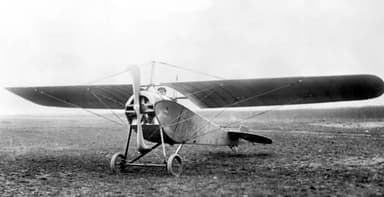
https://en.wikipedia.org/wiki/File:Nieuport-Macchi_Parasol.jpg
The Nieuport IV’s wing had obstructed the pilot’s and any observer’s downward view, and so the company placed the Parasol’s above the fuselage following the ‘sun visor’ or ‘parasol’ convention. For the rest, the aircraft largely adhered to the Nieuport IV specification as follows:
- Mainly wood construction covered with canvas
- Helical wooden two-bladed fixed-pitch propeller
- Bicycle landing gear with a rear skid in position
- No ailerons, wing warping was used to control roll
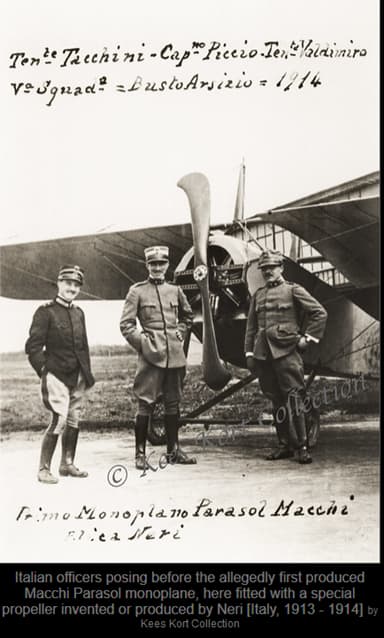
https://www.flickriver.com/photos/tags/macchi/interesting/
By May 1915 the Nieuport-Macchi Parasol was in regular use in the fledging French military aviation corps, because it was robust and easy to dismantle. However, it proved unstable and difficult to fly resulting in a high accident rate. Its inability to rise high enough to escape improving anti-aircraft fire proved its nemesis, and it retired from service in November 1915.
The specification of the aircraft was as follows:
- Length 23 ft, height 10 ft, wingspan 42 ft, wing area 258 sq ft, crew 2
- Empty weight 882 lb, gross 1,323 lb, 2-bladed helical fixed-pitch propeller
- Gnome 7 Lambda 7-cylinder air-cooled rotary piston engine, 80 hp
- Maximum speed 78 mph, stall speed 43 mph, range 250 mi
- Service ceiling 8,900 ft, time to achieve 6,500 ft altitude 26 minutes
Avro 504 – Most Produced World War 1 Aircraft (September 1913)
If production numbers are the criteria, then Avro 504 deserves the accolade. It first flew on September 18, 1913, and 8,970 were produced before the war was over. However, Avro and its affiliates continued manufacturing until 1932, by which time the tally was over 10,000.
The design was simple. Avro based their combo trainer / fighter / bomber on the earlier Avro 500 built for training and private flying. Thus it was a two-bay, all-wooden biplane with a square-section fuselage.
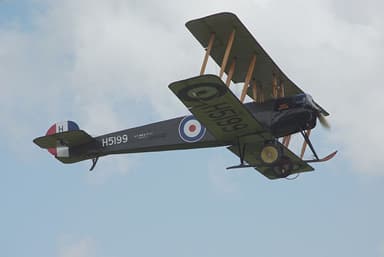
https://en.wikipedia.org/wiki/File:504_at_Old_Warden.jpg
The British Royal Flying Corps and Royal Naval Air Service purchased small numbers of Avro 504’s prior to the start of the First World War. They proved successful in the early days in France, and more orders followed.
However, they soon became obsolete as fighting aircraft, and became a base-line trainer instead. In 1918, they became the new backbone of British Home defense squadrons, where they resumed their role as fighters.
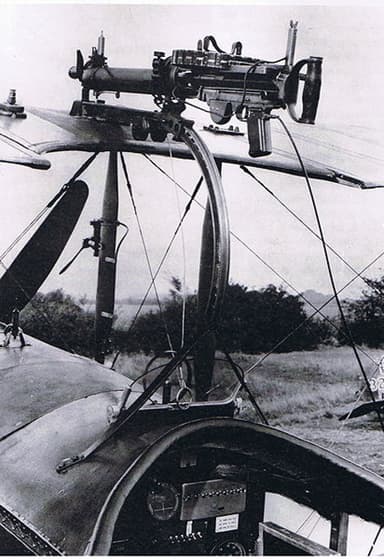
https://en.wikipedia.org/wiki/File:Foster_Mount_Avro504.jpg
Large numbers of war-surplus aircraft found new purposes when the war was over. The versatile airplanes became civilian trainers, pleasure aircraft, banner towers, and even stunt aircraft for barnstorming. They also lived on in peacetime defense forces in numerous other countries.
The specification (performance at sea level) was as follows:
- Length 29 ft, height 10 ft, wing span 36 ft, wing area 330 sq ft, crew 2
- Empty weight 1,231 lb, gross weight 1,829 lb, fuel capacity 31 US gal
- Le Rhône 9J 9-cylinder air-cooled rotary piston engine, 110 hp
- 2-bladed Avro fixed-pitch wooden propeller, 9 ft 0 diameter 8 ft 8 in pitch
- Max speed 95 mph, cruise speed 74 mph, stall speed 40 mph
- Endurance 2 to 4 hours depending on speed, service ceiling 16,000 ft
- Time to 3,500, 8,000 and 10,000 ft, 5, 10 and 16 minutes respectively
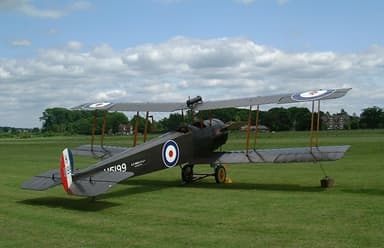
https://en.wikipedia.org/wiki/Avro_504#/media/File:Avro_504_by_ndrwfgg.jpeg

https://en.wikipedia.org/wiki/Avro_504#/media/File:Avro_504K_dwg.jpg
Sopwith Tabloid from Sports Aircraft to Fighter (November 1913)
The British Sopwith Aviation Company’s Sopwith Tabloid and Sopwith Schneider biplanes were among the company’s earliest offerings. The Tabloid caused a public sensation when it first flew on November 27, 2013 because of its small size.
However it was no lightweight when it came to performance. A 1914 floatplane variant comfortably won the Schneider Trophy race piloted by Howard Pixton and this became known as the Sopwith Schneider.
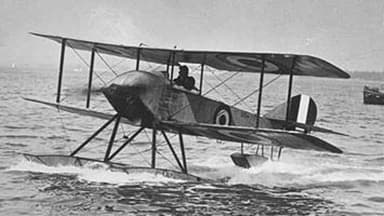
https://en.wikipedia.org/wiki/File:Sopwith_Schneider.jpg
The original Tabloid was a two-seater, single-bay biplane with side-by-side accommodation, equal span, slightly-staggered wings, and wing warping for sideways control.
The fuselage was a conventional wire-braced wooden structure, with the forward section covered in aluminum and the remainder, aft of the cockpit, covered in fabric. The engine cowling was almost completely enclosed, with cooling air flowing through two small slots at the front in an unusual innovation.

https://www.baesystems.com/en/heritage/sopwith-tabloid
The British War Office was impressed by the November maiden flight, and placed an initial order for nine single-seat examples. The provisional designation ‘Service Tabloids’ became ‘Sopwith Scout’ in mid-December 1913, with prescribed use as high-speed scouts and dispatch carriers.
The specification was as follows:
- Length 22 ft, height 10 ft, wingspan 25 ft, wing area 240 sq ft, crew 1 to 2
- Empty weight 1,220 lb, gross weight 1,700 lb, 2-bladed wooden propeller
- Gnome Monosoupape 9 Type B-2 9-cylinder rotary engine, 100 hp
- Max speed 87 mph, range 510 mi, ceiling 7,000 ft, 6,500 ft in 15 min

1914
The outbreak of World War 1 speeded aviation development considerably, and this changed warfare in two ways. The battlefield extended into the sky, and the boundary between front line and hinterland, even homeland became blurred. Approximately 20,000 people, mainly trained pilots perished in an effort that ended in a virtual stalemate, but foresaw the birth of modern aviation.
First Regular, Heavier Than Air Passenger Services (January 1914)
The St. Petersburg–Tampa Airboat Line was the first service provider using a scheduled fixed wing passenger aircraft. It began services in January 1914, and continued through to May. Flights were between St. Petersburg, Florida and neighboring Tampa, 23 miles away across Tampa Bay.
The chosen aircraft were a pair of purpose-built Benoist XIV’s, with the by-line The Lark of Duluth, and manufactured by Thomas W. Benoist. This was a conventional biplane with equal-span, un-staggered wings, and small pontoons at their tips. The pilot and single-passenger were in a side-by-side arrangement in an open cockpit.

https://en.wikipedia.org/wiki/File:Benoist_Type_XIV_first_airline_takeoff.jpg
The first of the two aircraft carried joy riders over the harbor at Duluth, Minnesota through the summer of 1913, but was not a commercial success and the aircraft was damaged in an accident. The commercial version was more successful, and carried 1,205 passengers for a single fee of $5 across Tampa Bay.
However, Tampa city’s subsidy ended in March, whereafter the operation was no longer profitable. Lark of Duluth spent the rest of 1914 carrying joyriders at Duluth, Conneaut Lake, and San Diego until damaged in a hard landing. The venture served as a prototype for today’s global airline industry.

https://en.wikipedia.org/wiki/File:Benoist_xiv.jpg
The specification of the aircraft was as follows:
- Length 26 ft, wingspan 44 ft, empty weight 1,250 lb, 1 pilot, 1 passenger
- Roberts straight-6 motor 75 hp, max speed 64 mph, range 125 mi

https://en.wikipedia.org/wiki/Benoist_XIV#/media/File:Benoist_XIV_Cedar_Point.jpg
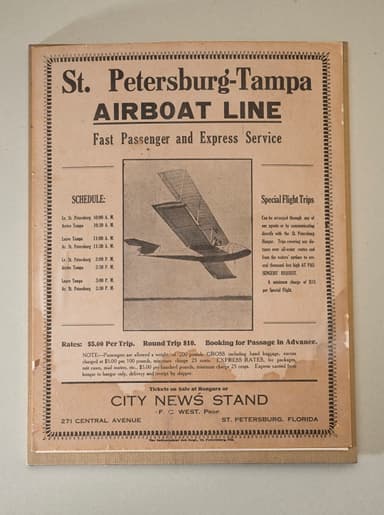
https://airandspace.si.edu/collection-objects/st-petersburg-tampa-airboat-line/nasm_A19900420000
Germany Makes Its Weight Felt in Fixed Wing Aviation (Feb 1914)
Germany had hitherto taken a back seat in heavier than air flight, although there was ongoing activity in the background.
- On February 3, 1914 German aviator Bruno Langer set a new flight endurance record in an unidentified airplane, flying nonstop for 14 hours 7 minutes.
- On February 7, 1914 German aviator Karl Ingold beat that record by flying nonstop for 16 hours 20 minutes in an Aviatik biplane.
- On February 11, 1914 German aviator Bruno Langer tried to recover the lead in an LFG Roland Pfeilflieger biplane, but landed 20 minutes short.
- On June 24, 1914 German aviator Gustav Basser set a new flight endurance record, flying nonstop for 18 hours 10 minutes in an unknown aircraft.
- On July 10 – 11, 1914 German aviator Reinhold Böhm flew his Albatros biplane for 24 hours and 12 minutes without refueling and nonstop. His record endured until 1927.
USS Tests Its Military Aviation Wings at Veracruz (April 1914)
The United States became embroiled in the Mexican Revolution in 1914. On April 20th, battleship USS Mississippi headed for Veracruz with three aging Curtiss seaplanes to fly reconnaissance missions on behalf of troops on the ground.
The first U.S. combat aerial mission ever took place on April 25, when one aircraft observed Mexican positions successfully during the Veracruz occupation.
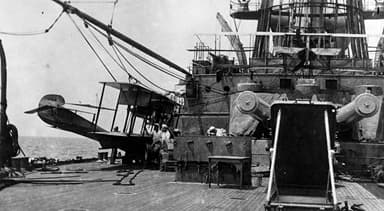
https://commons.wikimedia.org/wiki/File:Mississippi_-_Airplanes.jpg
Royal Navy Starts Building Its First Seaplane Carrier (May 1914)
The British Royal Navy purchased the first aircraft carrier, Ark Royal, when she was little more than a keel and framework. This made it possible to modify the vessel for seaplanes. By the time she was commissioned in December she would have:
- Capacity for five floatplanes, and between two and four wheeled aircraft
- A working deck for starting, running up, and recovering seaplanes
- A aircraft hold 150ft by 45 ft by 15 ft, alongside extensive work shops
- Cranes able to lift airplanes through a hatch to the deck or the water
Her original complement included a Short Folder, two Wight Pushers, three Sopwith Type 807 seaplanes, and two-to-four Sopwith Tabloid wheeled aircraft.

https://en.wikipedia.org/wiki/HMS_Ark_Royal_(1914)#/media/File:Ark_Royal_NARA_45513193.jpg
First French Shipboard Take Off by René Caudron (May 1914)
Brothers Gaston and René Caudron were among the earliest aircraft manufacturers in France. They produced planes for the military in both World War I and World War II.
On May 8, 1914 René Caudron made the first French shipboard take off in an airplane from a ramp constructed over the foredeck of the seaplane carrier Foudre. The aircraft was one of the company’s Caudron G.3 amphibian floatplanes.
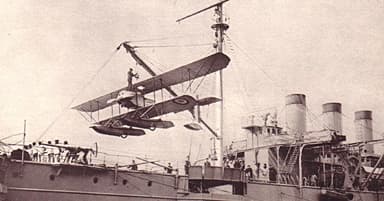
https://en.wikipedia.org/wiki/Caudron#/media/File:CaudronLaFoudre.jpg
The Caudron G3 was a popular World War I reconnaissance aircraft, and trainer that first flew in December 1913. It had a short housing for the pilot, a single engine in the nose of the nacelle, and an open tail boom truss. The wings were a sesquiplane biplane arrangement. Early models used wing warping for lateral control.
The specification was as follows:
- Length 21 ft, height 8 ft, wing span 44 ft, wing area 290 sq ft, crew 1
- Empty weight 926 lb, take-off max 1,565 lb, 2 bladed fixed-pitch propeller
- Le Rhône 9C 9-cylinder air-cooled rotary piston engine, 80 hp
- Max speed 66 mph, endurance 4 hrs, service ceiling 14,100 ft
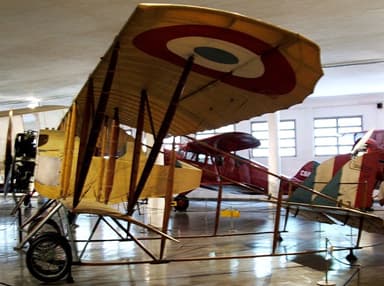
https://en.wikipedia.org/wiki/Caudron_G.3#/media/File:Caudron_G3_musal.jpg
A Timely Reminder of The Perils of Airborne Flight (June, 1914)
World War 1 would see military aircraft flying close to each other in dangerous maneuvers, each trying to outwit the other while desperately trying to land the killer shot. An example of these perils occurred on June 20, 1914 not long before the conflict began.

https://www.historynet.com/gallery-wwi-planes.htm
An Austro-Hungarian airship model Militärluftschiff III was hovering over Fischamend in Lower Austria, testing new camera equipment on June 20, 1914. An Austro-Hungarian Army pilot decided to loop around it in a Farman biplane for an unknown reason.
The Farman biplane struck the top of the airship, tearing a hole and igniting the escaping, flammable hydrogen gas. The pilot and observer were killed along with all seven men aboard the airship. Both aircraft were utterly destroyed.

https://www.akg-images.com/archive/-2UMDHUWHLRAXF.html
Aviatik B.1 Captures German Air Force Interest (Mid-1914)
The German Automobil und Aviatik AG company created a number of sporty biplanes from 1912 onwards, although most of the production was for Hungary. There were several Aviatik B.1 variants through to 1919 when the Treaty of Versailles obliged it to cease operations.
The pre-war 3½-bay or 4-bay biplanes were widely used in competitions and gained a high reputation. In 1913 the German air force ordered 100 smaller reconnaissance versions with 2-bay or 3-bay wings and a tail fin.

The general specification of Aviatik B variants was as follows:
- Length 26 ft, height 10 ft, wing span 45 ft
- Empty weight 1,473 lb, gross weight 2,403 lb
- 2 crew in open tandem cockpits with the observer in the front
- Mercedes D.I 6-cylinder liquid-cooled inline engine 103 hp
- Max speed 62 mph, range 500 mi, 15 min to 3,300 ft
First Flight of Curtiss Model H Flying Boat America (June 1914)
Curtiss Aeroplane and Motor Company developed two long range flying boats in response to a prize offered by the London newspaper, Daily Mail in 1913, for the first non-stop fixed-wing aerial crossing of the Atlantic. The Curtiss aircraft were special variants of their Model H with transatlantic range and cargo-carrying capacity
Pioneers Glenn Curtiss and John Cyril Porte took advantage of finance offered by air enthusiast Rodman Wanamaker. Porte oversaw the construction of two scaled-up prototypes with wing tip pontoons in the UK, and also fulfilled the role of test pilot.

https://en.wikipedia.org/wiki/File:Porte_%26_Hallett_on_%22America%22.jpg
Early trials were bedeviled by the aircraft nose tending to submerge during take-off. However, they solved this by fitting sponson floats on either side of the hull. The first flight of the America was on June 23, 1914, after which plans were confirmed to commence the crossing on August 5, 1914 to take advantage of the full moon.
The outbreak of World War 1 five weeks later interrupted these plans. Porte was recalled to service with the British Royal Navy. All was not lost though. The British Admiralty commandeered, and later purchased the two prototypes based on his feedback, followed by an order for 12, smaller versions after war broke out.
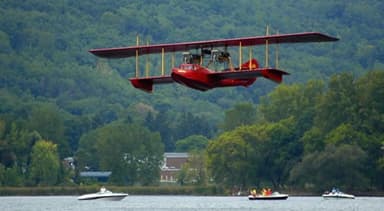
https://www.glennhcurtissmuseum.org/curtiss-america.php
Specification of Curtiss Museum Replica:
- Two overhauled 100 hp special OXX6 engines
- Final weight with crew, fuel and oil 4,100lb
- 72-ft. upper and 46-ft. lower wing spans, 7 ft chord
- Similar wing-area-to-weight ratio as Piper J-3 Cub
- 17 ft ailerons for roll, smaller elevators for pitch control
- Cruising 65 mph, approach 55 mph, landing speed 40 mph
Vickers Gunbus – World’s First Purpose-Built Fighter (July 1914)
The Vickers F.B.5 (Fighting Biplane 5) (known as the “Gunbus”) was a British two-seat pusher military biplane of the First World War. The two-seater aircraft had a .303 inch Lewis machine gun in front of the nacelle operated by the observer / gunner.
The Gunbus is largely accepted as the world’s first operational fighter aircraft. Work began in 1912, but continued through to July 17, 1914 that saw the first successful flight. The pusher configuration resolved the problem of firing through a tractor propeller, making it an effective weapon.

https://commons.wikimedia.org/wiki/File:RAF_Vickers_FB5_Gunbus.jpg
The first Vickers F.B 5 saw action on December 25, 1914 when it engaged, and possibly downed a German Taube monoplane. Eighteen days later another one force-landed behind German lines, and the ‘trade secrets’ became enemy knowledge.
However, the aircraft turned out to be too cumbersome to achieve a speed or rate of climb necessary to pursue its quarry. This may have been the reason why only one pilot / observer team became aces after shooting down five or more enemy aircraft during aerial combat.
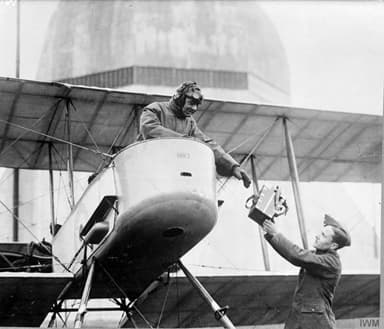
https://commons.wikimedia.org/wiki/File:Vickers_Gunbus_Ministry_of_Information_First_World_War_Miscellaneous_Collection_Q33814.jpg
The German Fokker Eindecker outclassed the Gunboat by 1915, to the extent the remaining (improved) F.B.9’s retired to the less active role of pilot trainers. The original specification was as follows:
- Length 27 ft, height 11 ft, wingspan 36 ft, wing area 382 sq ft
- Empty weight 1,220 lb, gross weight 2,050 lb, pilot and observer / gunner
- Gnome Monosoupape 9-cylinder rotary engine 100 hp, service ceiling 9,000 ft
- Max speed 70 mph, range 250 mi, endurance 4.5 hrs, 16 minutes to 5,000 ft
- 1 × 0.303 inch drum-fed Lewis gun in observer’s cockpit on swivel mount
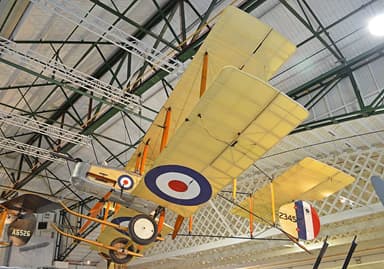
https://commons.wikimedia.org/w/index.php?search=vickers+gunbus&title=Special:Search&go=Go&ns0=1&ns6=1&ns12=1&ns14=1&ns100=1&ns106=1#/media/File:Replica_Vickers_FB.5_Gunbus_’2345’_(G-ATVP)_(16883476747).jpg
First Operational Flights in Europe by Naval Aircraft (July, 1914)
The Balkan Wars of 1912 and 1913 resulted in Montenegro becoming a kingdom in newly-created Albania. However, tensions continued to simmer in a territory that would become one of the Allied Powers during World War I.
The Austro Hungarian Navy dispatched three battleships in July 1914, to conduct reconnaissance of the border with Montenegro. Each of these carried one Lohner flying boat. They conducted the first operational flights in Europe by naval aircraft.
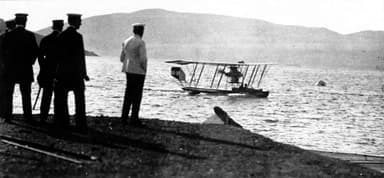
http://unaltrocampo.blogspot.com/2014/07/the-lohner-flying-boats.html
The specification of the later Model E Lohner seaplane was as follows:
- Length 33 ft, height 12 ft, wing span 53 ft, crew pilot and observer
- Gross weight 3,747 lb, engine manufactured by Otto Hieronimus
- Maximum speed 65 mph, endurance 4 hrs, service ceiling 13,120 ft
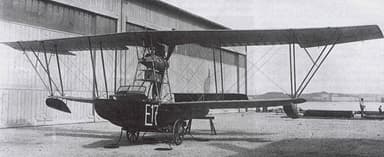
https://en.wikipedia.org/wiki/File:Lohner_E_flying_boat.jpg
World War Breaks Out Over a Slumbering World (July 28, 1914)
The leading nations of the world had been virtually skirmishing for a while, as they built fleets of giant battleships, and experimented with their fledgling weapon, aircraft. This war would be the first time fixed-wing aircraft joined battle with tethered balloons and dirigibles in large numbers. However, their role would still be limited.
The German forces had a fleet of 11 Zeppelins for artillery spotting, and reconnaissance, but only 2 Taube airplanes. However, they soon withdrew the Zeppelins from the front when anti-aircraft fire began to decimate them, and reassigned them for bombing London to cause panic among the population.
Fixed-wing airplanes had only begun to reach battle-worthy status in France and England. The Royal Navy Air Service had 52 seaplanes, of which only 26 were serviceable, with 46 more on order. Neutral Italy had 28 combat-ready aircraft and 18 military aircraft in reserve, but only joined the war in May 1915.
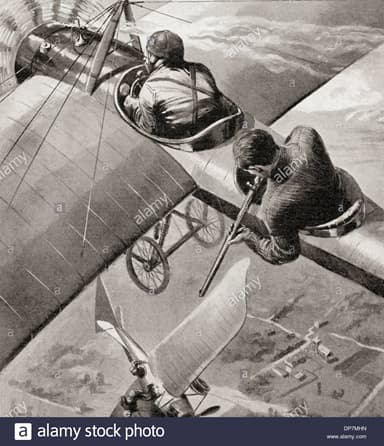
Link to Image
However, their role would remain largely a reconnaissance one, as inexperienced, inadequately-trained pilots learned by trial and error. Those young men became folk-heroes at home, as the survivors honed new fighting, bombing and trench-strafing skills.
British Short Type 81 Floatplane Launches Torpedo (July 1914)
Royal Naval Air Service squadron commander Arthur Longmore successfully released a 14-inch torpedo from a Short Admiralty Type 81 floatplane on July 28, 1914.
This may have been the first successful aerial launch, although Italian Captain Alessandro Guidoni dropped an experimental torpedo from a Pateras Pescara monoplane in ‘mid-1914’ which may have been earlier.
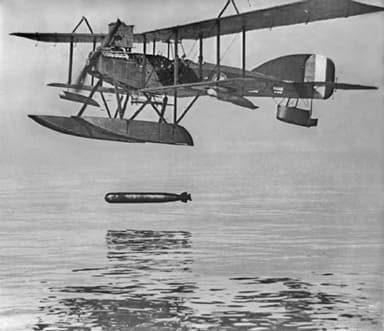
https://en.wikipedia.org/wiki/Short_Type_320#/media/File:IWM-Q27453-Short-320.jpg
Avro 511 Adds to A.V. Roe’s Litany of Woes (July 1914)
Meanwhile, the A. V. Roe company seemed to be going through a bad patch. The Avro Type D float plane vanished from the pages of history in May 1914. The Avro 511 fast scouting biplane had innovative features, but failed to enter production after World War 1 broke.
For a while it seemed the Avro 511 two-seater racing seaplane would make a difference to the company’s fortunes. The design of the conventional biplane was solid, with greatly uneven wing span, and two large central floats and two outriggers.
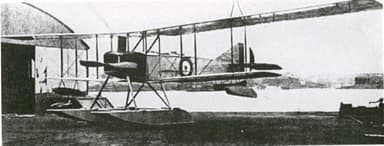
https://en.wikipedia.org/wiki/File:Avro_510.jpg
Avro designed the 511 with an eye on the 1914 Circuit of Britain Race, which was abandoned when hostilities began. However, the British Admiralty was sufficiently impressed to order five examples, with modified floats and tails. And then it discovered the aircraft could barely fly with a second person on board.
The Admiralty returned the aircraft to Supermarine for modification and improvement. However, they were withdrawn from service in March 1915 for reasons that are unclear.

http://flyingmachines.ru/Site2/Crafts/Craft28884.htm
The specification of the aircraft was as follows:
- Length 38 ft, wingspan 63 ft, wing area 564 sq ft, crew 1
- Empty weight 2,080 lb, gross 2,800 lb, 2-bladed fixed-pitch propeller
- Sunbeam Crusader V-8 water-cooled piston engine, 150 hp
- Max speed 70 mph, endurance 4 hrs, 41⁄2 minutes to 1,000 ft (?)
Republic of China Uses Aircraft to Harass Rebels (1914)
The Banghai Bandit rebellion lasted from mid-1913 to late the following year, and festered after the Second Revolution was over. In early-to-mid-1914 the rebels attempted a breakout to a sympathetic neighbouring province.
However, the Chinese government deflected this drive with determined military pressure, including, perhaps its first use of aircraft in warfare. Unconfirmed reports suggest this may have included aerial bombing missions.
If this were to have been the case, then the aircraft may well have been Caudron G.3’s, of which China purchased 12 from France in 1913. They proved suitable for reconnaissance flights in World War 1, being stable and having good visibility.

https://commons.wikimedia.org/wiki/File:Caudron_G.3_in_Chinese_service.jpg
The Combatant Nations Prepare for War (July to Sept, 1914)
The first few months were tantamount to a virtual war, as combatant nations prepared their forces, including aircraft and pilots such as they had.
- The Imperial German Army leased a cargo-passenger ship for conversion to Germany’s first seaplane mothership SMS Answald on August 3, 1914.
- Twelve Royal Aircraft Factory B.E.2 observation aircraft became the first British airplanes to arrive in France, after a flight from Dover on August 13, 1914.
- The Japanese Imperial Navy recommissioned its first aviation ship, Wakamiya as a seaplane carrier on August 17, 1914.
- The Royal Navy’s Eastchurch Squadron of 19 aircraft arrived in France for service as surveillance / spotting aircraft on August 27, 1914.
- The Curtis Model H flying boats for the first aerial crossing of the Atlantic shipped to the UK on September 30, 1914 as prototypes for anti-submarine patrols and sea rescues.
Bréguet Bre.4 Pusher Bomber Has Mixed Reception (August 1914)
Development of the French Bréguet Bre.4 pusher bomber was nearing completion when Bréguet Aviation had to relocate from Douai to Villacoublay to avoid the approaching German army.
The design reflected French military planners’ preference for pusher- over tractor-configured aircraft. Bréguet obliged with a two-bay, equal-span, un-staggered biplane in order to pursue military contracts.
The aircraft seated the pilot and observer in tandem open cockpits, in a nacelle that also carried the pusher engine at its rear, and the tricycle undercarriage beneath.

https://en.wikipedia.org/wiki/File:Breguet_de_Chasse.jpg
André and Édouard Michelin approached the French government with an offer to sponsor the construction of 100 bombers for the French Army as the German invasion threatened. Production accelerated with an order for 100 type BUM bombers.
The French Army followed up with an order for a BUC escort fighter version shortly afterwards. Bréguet responded with a lighter version armed with a 1.46 in Hotchkiss cannon to pick off enemy fighters before they closed to within range of their machine guns.

http://www.aviastar.org/air/france/breguet_blc.php
However, in the end few BUM and BUC / BLC aircraft were constructed after their performance and utility were discovered to be lacking. Military focus shifted from cannon-armed escort fighters, to fighter planes capable of operating on their own.
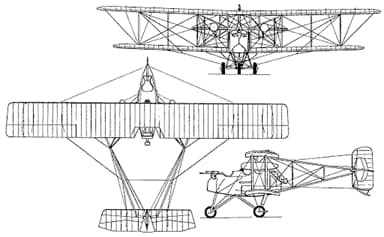
http://www.aviastar.org/air/france/breguet_blc.php
The specification for the BUC escort fighter version was as follows:
- Length 21 ft, height 12 ft, wingspan 53 ft, wing area 581 sq ft
- Empty weight 2,557 lb, gross weight 3,384 lb, pilot and gunner
- Salmson 2M7 water cooled radial pusher engine, 200 hp
- Max speed 86 mph, range 250 mi, endurance three hours
- Trainable 1.46 in Hotchkiss cannon, 660 lb bomb load
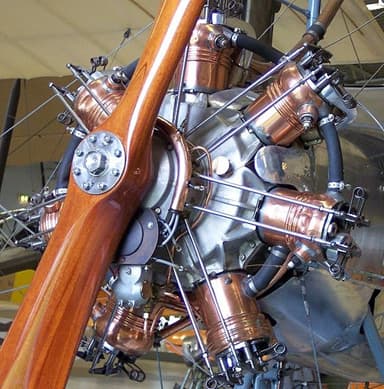
https://commons.wikimedia.org/wiki/File:Emile_Salmson_watercooled_radial_engine_1915.jpg
The First Aerial Combat Sorties (July to August, 1914)
- The first true bomber aircraft, the French Voisin III attacked German airship hangars at Metz-Frascaty, Germany on August 14, 1914.
- German rifle fire brought down a British Avro 504 aircraft while on patrol over Belgium, making it the first British aviation casualty on August 22, 1914.
- An attempt to use a Lewis gun in a British Farman aircraft failed when the gun’s weight slowed the climbing rate to 30 minutes / 1,000 feet on August 22, 1914.
- A Russian Army pilot in a Morane-Saulnier Type G monoplane achieved the first aerial kill after he rammed an Austro-Hungarian Albatros B.II on August 25, 1914.
- A German Etrich Taube aircraft dropped 6.6 lb bomblets and propaganda leaflets on Paris during a propaganda mission on August 30, 1914.
Aerial Defense Strategy Established for United Kingdom (Sep 1914)
First Sea Lord Winston Churchill established a policy for the air defense of the United Kingdom in early September 1914. This involved:
- Searchlights and anti-aircraft artillery to be placed at likely targets
- British aircraft to intercept enemy aircraft between Dover and London
- Telephone and telegraph operators to coordinate operations based at Hendon
- Blackout imposed on major cities, air crew prepared for night fighting
- Public education program for taking shelter under aerial attack
Japanese Seaplane Carrier Engages in First Combat (Sep 1914)
The Imperial Japanese seaplane carrier Wakamiya arrived off Kiaochow Bay, China on September 1, 1914, to attack the German port of Tsintao. This was the first combat deployment of an aviation ship by any country.
Wakamiya launched its first mission on September 5, 1914 when she dispatched a three-seat Farman seaplane to bomb German fortifications and conduct a reconnaissance of nearby Kiaochow Bay.

https://www.reddit.com/r/HistoryPorn/comments/3asemr/wwi_japanese_ship_wakamiya_launching_a_maurice/
On September 6, 1914 a Farman aircraft launched by Wakamiya attacked the Austro Hungarian cruiser Kaiserin Elisabeth, and the German gunboat Jaguar in Qiaozhou Bay. However neither ship was hit.
Then on September 30, 1914 Wakamiya struck a German sea mine and withdrew from the conflict temporarily. However, her Farman aircraft continued operating from a land base. They used the equivalent of twelve-pounder bombs, but never took a hit despite constant bombardment by enemy shrapnel.
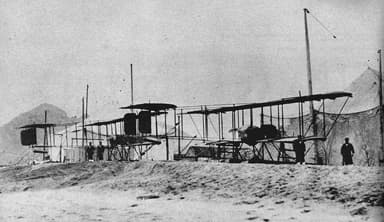
https://en.wikipedia.org/wiki/Japanese_seaplane_carrier_Wakamiya#/media/File:FarmanTsingtao.jpg
More Firsts in the Military Use of Aircraft (Sep to Oct 1914)
- British anti-aircraft unit shoots down an unidentified enemy aircraft on September 23, 1914.
- A French Voisin III shoots down a German Aviatik B.II with machine gun fire on October 5, 1914.
- Two British Sopwith Tabloids raid the Zeppelin sheds at Düsseldorf. The one that found the target achieves the first dirigible kill on October 8, 1914.
- Germany commences sea-air operations when an armored cruiser embarks two seaplanes to scout Russian Baltic ports in early November, 1914.
- Three French-based British Avro 504s conduct a long-range strategic bombing raid on German airship sheds at Lake Constance on November 21, 1914
- The first air-sea battle takes place when Japanese Navy Farman seaplanes attempt to bomb German and Austro-Hungarian ships on November 27, 1914.
Bréguet Bre.4 Pusher Bomber Has Mixed Reception (August 1914)
Development of the French Bréguet Bre.4 pusher bomber was nearing completion when Bréguet Aviation had to relocate from Douai to Villacoublay to avoid the approaching German army.
The design reflected French military planners preference for pusher- over tractor-configured aircraft in order to pursue military contracts. Bre.4 was a two-bay, equal-span, un-staggered biplane.
It seated the pilot and observer in tandem open cockpits in a nacelle that also carried the pusher engine at its rear, and the tricycle undercarriage beneath.
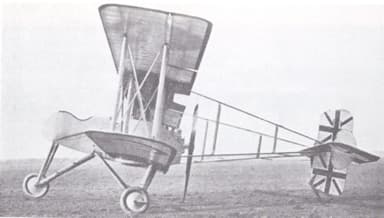
https://en.wikipedia.org/wiki/File:Breguet_de_Chasse.jpg
André and Édouard Michelin approached the French government with an offer to sponsor the construction of 100 bombers for the French Army, as the German invasion threatened. Production accelerated with an order for 100 type BUM bombers.
The French Army followed up with an order for a BUC escort fighter version shortly afterwards. Bréguet responded with a lighter version armed with a 1.46 in Hotchkiss cannon, to pick off enemy fighters before they closed to within range of their machine guns.

http://www.aviastar.org/air/france/breguet_blc.php
However, in the end few BUM and BUC / BLC aircraft were constructed after their performance and utility were discovered to be lacking. Military focus shifted from cannon-armed escort fighters, to fighter planes capable of standing on their own.
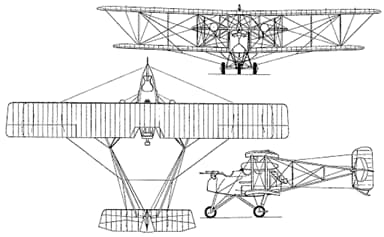
http://www.aviastar.org/air/france/breguet_blc.php
The specification on the BUC escort fighter version was as follows:
- Length 21 ft, height 12 ft, wingspan 53 ft, wing area 581 sq ft
- Empty weight 2,557 lb, gross weight 3,384 lb, pilot and gunner
- Salmson 2M7 water cooled radial pusher engine, 200 hp
- Max speed 86 mph, range 250 mi, endurance three hours
- Armament trainable 1.46 in Hotchkiss cannon, 660 lb bomb load
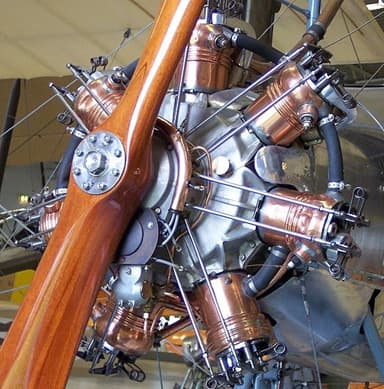
https://commons.wikimedia.org/wiki/File:Emile_Salmson_watercooled_radial_engine_1915.jpg
Bristol Scout Biplane Racer Becomes Fighter Aircraft (Nov 1914)
The British and Colonial Aeroplane Company first flew their single-seat rotary-engine biplane on February 23, 1914. They had high hopes of it winning competitions until World War 1 intervened, and it became the military version of the Bristol Scout.
The single span biplane was stripped of all luxuries, although it did benefit from ailerons fitted to the upper and lower wings. It featured at the March 1914 Aero Show at Olympia in London after the first flight.

https://en.wikipedia.org/wiki/File:Bristol_Scout_Prototype_in_March_1914.jpg
The British military evaluated the Bristol Scout on May 14, 1914 at Farnborough, where it achieved a speed of 97.5 mph. They then requisitioned available stock when war broke out, and ordered a further 12 in November. Many more followed.
The Bristol Scout served from l914 through to 1918 and marked the genesis of the fighter aircraft as a distinct type. It also saw the earliest attempts to arm British tractor configuration aircraft with forward-firing guns, mounted on either side of the fuselage.
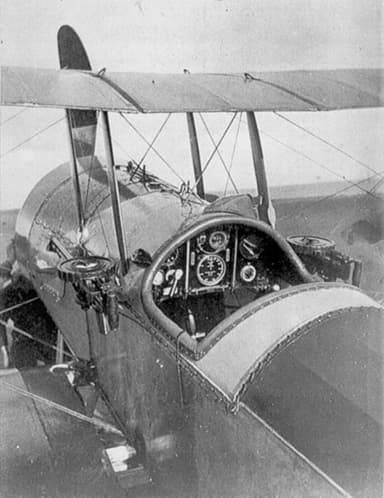
https://en.wikipedia.org/wiki/File:RNAS_Bristol_Scout_D_w-twin_Lewis_guns.jpg
The original specification of the airplane was as follows;
- Length 20 ft, height 8 ft, wing span 24 ft, wing area 198 sq ft
- Empty weight 789 lb, gross weight 1,196 lb, crew 1
- Le Rhône 9C 9-cylinder air-cooled rotary piston engine, 80 hp
- Max speed 94 mph, range 187 mi, endurance 2.5 hours
- Service ceiling 16,000 ft, 18 min to 10,000 ft
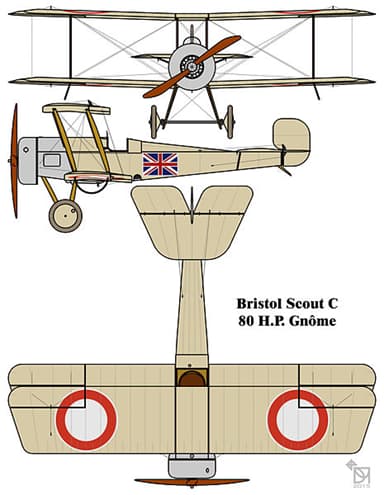
https://en.wikipedia.org/wiki/File:Bristol_Scout_C_British_First_World_War_fighter_biplane_drawing_in_RNAS_markings.jpg





